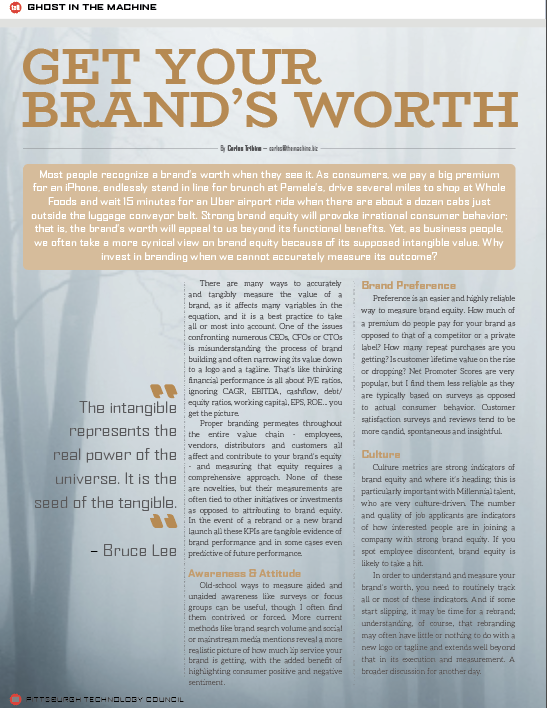Get Your Brand’s Worth
By Carlos Tribino, The Machine
 Most people recognize a brand’s worth when they see it. As consumers, we pay a big premium for an iPhone, endlessly stand in line for brunch at Pamela’s, drive several miles to shop at Whole Foods and wait 15 minutes for an Uber airport ride when there are about a dozen cabs just outside the luggage conveyor belt.
Most people recognize a brand’s worth when they see it. As consumers, we pay a big premium for an iPhone, endlessly stand in line for brunch at Pamela’s, drive several miles to shop at Whole Foods and wait 15 minutes for an Uber airport ride when there are about a dozen cabs just outside the luggage conveyor belt.
Strong brand equity will provoke irrational consumer behavior; that is, the brand’s worth will appeal to us beyond its functional benefits. Yet, as business people, we often take a more cynical view on brand equity because of its supposed intangible value. Why invest in branding when we cannot accurately measure its outcome?
There are many ways to accurately and tangibly measure the value of a brand, as it affects many variables in the equation, and it is a best practice to take all or most into account. One of the issues confronting numerous CEOs, CFOs or CTOs is misunderstanding the process of brand building and often narrowing its value down to a logo and a tagline. That’s like thinking financial performance is all about P/E ratios, ignoring CAGR, EBITDA, cashflow, debt/equity ratios, working capital, EPS, ROE... you get the picture.
Proper branding permeates throughout the entire value chain - employees, vendors, distributors and customers all affect and contribute to your brand’s equity - and measuring that equity requires a comprehensive approach. None of these are novelties, but their measurements are often tied to other initiatives or investments as opposed to attributing to brand equity. In the event of a rebrand or a new brand launch all these KPIs are tangible evidence of brand performance and in some cases even predictive of future performance.
Awareness & Attitude
Old-school ways to measure aided and unaided awareness like surveys or focus groups can be useful, though I often find them contrived or forced. More current methods like brand search volume and social or mainstream media mentions reveal a more realistic picture of how much lip service your brand is getting, with the added benefit of highlighting consumer positive and negative sentiment.
Brand Preference
Preference is an easier and highly reliable way to measure brand equity. How much of a premium do people pay for your brand as opposed to that of a competitor or a private label? How many repeat purchases are you getting? Is customer lifetime value on the rise or dropping? Net Promoter Scores are very popular, but I find them less reliable as they are typically based on surveys as opposed to actual consumer behavior. Customer satisfaction surveys and reviews tend to be more candid, spontaneous and insightful.
Culture
Culture metrics are strong indicators of brand equity and where it’s heading; this is particularly important with Millennial talent, who are very culture-driven. The number and quality of job applicants are indicators of how interested people are in joining a company with strong brand equity. If you spot employee discontent, brand equity is likely to take a hit.
In order to understand and measure your brand’s worth, you need to routinely track all or most of these indicators. And if some start slipping, it may be time for a rebrand; understanding, of course, that rebranding may often have little or nothing to do with a new logo or tagline and extends well beyond that in its execution and measurement. A broader discussion for another day.